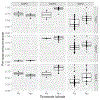Geographic disparities impacting oral vaccine performance: Observations and future directions
- PMID: 39774633
- PMCID: PMC11773816
- DOI: 10.1093/cei/uxae124
Geographic disparities impacting oral vaccine performance: Observations and future directions
Abstract
Oral vaccines have several advantages compared with parenteral administration: they can be relatively cheap to produce in high quantities, easier to administer, and induce intestinal mucosal immunity that can protect against infection. These characteristics have led to successful use of oral vaccines against rotavirus, polio, and cholera. Unfortunately, oral vaccines for all three diseases have demonstrated lower performance in the highest-burden settings where they are most needed. Rotavirus vaccines are estimated to have >85% effectiveness against hospitalization in children <12 months in countries with low child mortality, but only ~65% effectiveness in countries with high child mortality. Similarly, oral polio vaccines have lower immunogenicity in developing country settings compared with high-resource settings. Data are more limited for oral cholera vaccines, but suggest lower titers among children compared with adults, and, for some vaccines, lower efficacy in endemic settings compared with non-endemic settings. These disparities are likely multifactorial, and available evidence suggests a role for maternal factors (e.g. transplacental antibodies, breastmilk), host factors (e.g. genetic polymorphisms-with the best evidence for rotavirus-or previous infection), and environmental factors (e.g. gut microbiome, co-infections). Overall, these data highlight the rather ambiguous and often contradictory nature of evidence on factors affecting oral vaccine response, cautioning against broad extrapolation of outcomes based on one population or one vaccine type. Meaningful impact on performance of oral vaccines will likely only be possible with a suite of interventions, given the complex and multifactorial nature of the problem, and the degree to which contributing factors are intertwined.
Keywords: attenuated vaccines; cholera; live; oral vaccines; polio; rotavirus.
© The Author(s) 2025. Published by Oxford University Press on behalf of the British Society for Immunology. All rights reserved. For commercial re-use, please contact reprints@oup.com for reprints and translation rights for reprints. All other permissions can be obtained through our RightsLink service via the Permissions link on the article page on our site—for further information please contact journals.permissions@oup.com.
Conflict of interest statement
Conflicts of interest
The authors report no conflicts of interest.
Figures



References
-
- World Health Organization. History of polio vaccination. Available at: https://www.who.int/news-room/spotlight/history-of-vaccination/history-o.... Accessed June 14.
-
- Holmgren J, Czerkinsky C. Mucosal immunity and vaccines. Nat Med 2005; 11(4 Suppl): S45–53. - PubMed
Publication types
MeSH terms
Substances
LinkOut - more resources
Full Text Sources
Medical

